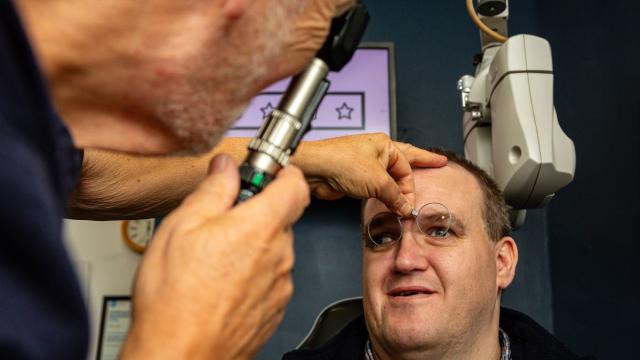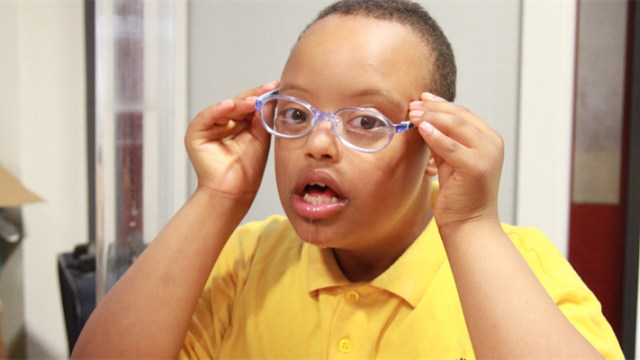Children and young people
All children should have their eyes and vision checked regularly by an eye care professional. Children with learning disabilities are more at risk of having problems and may be less likely to be able to communicate them, so regular eye care is essential. It is recommended that all children who have a learning disability have a full eye examination (eye test) at least once a year.
As part of the Healthy Child Programme, children should be offered an eye check in the newborn period and in reception year (age four-five) at school. However, it is important to realise that these checks are designed to identify some, but certainly not all, problems that can affect eyes or vision, and that in some areas not all children are offered a school entry check.
It is not necessary for a child to be able to read or even speak in order for eye professionals to assess what a child can see or if they would benefit from glasses to make seeing easier.
Where to access eye care
Some areas have vision screening programmes in schools - often delivered by orthoptists - where vision is checked upon entry to school at age four to five and sometimes throughout school. The screening tests may vary from just a check on distance vision to also checking close vision and how the eyes work as a pair. However, vision screening is not as detailed a check as a full eye test and some children may pass even if they have a problem with their eyes or vision.
All children under the age of 16 (or 19 if in full time education) are entitled to a free NHS eye test carried out by an optometrist at a community opticians. You can arrange this yourself and don’t need to be referred. This test will include checking vision for far and near, how the eyes work as a pair, how the eyes are focused (to see if glasses are needed) and the health of the eyes inside and outside.
If you see a paediatrician, they may be able to help you access specialist children’s vision clinics set up at child development centres, health centres, or paediatric outpatients through hospital services.
Your GP can help with eye infections and refer you to the eye clinic at the hospital for serious concerns.
You can use our forms to tell any eye care professional about your child and their eyes. This will help them to assess your child’s eyes appropriately and it is a good idea to get this form to them before the eye test so that they can be prepared.
A child's eye test
All children are entitled to a free NHS annual eye test. This is usually provided in the community by an optometrist (ophthalmic optician). Children who have learning or physical disabilities that make communicating or interacting difficult can still have an eye test, as there are lots of ways of doing it. Everyone can have an eye test – you don’t need to be able to read or speak.
To help, we have a video and an easy read factsheet for children who are Makaton users.
There are four main parts of the test:
- Checking how well you can see - this can be done by using tests adapted for children, such as a picture test rather than letters, or by using tests that watch how the child responds to different visual stimuli
- Checking how well the eyes focus (to see if glasses are needed) - this can be done just by looking at the eyes with a specialist instrument (a retinoscope) and you don’t need to be able to say when things look clearer
- Checking how well the eyes move and work together to give 3D vision - this can be done with lights and toys and special picture tests (stereotests)
- Checking the health of the inside and outside of the eyes - this can be done by shining a light into the eyes (an ophthalmoscope)
Reasonable adjustments
It’s possible to make reasonable adjustments to the eye test to make it accessible for children with learning disabilities. Many of these adjustments take place prior to the child arriving in the opticians or eye clinic. To have the best chance of a successful visit, it is helpful to highlight the child’s additional needs before the day of the appointment.
Examples of reasonable adjustments include:
- Visiting the practice or hospital before the day of the eye test to aid familiarisation with the rooms
- Arranging the appointment during a quieter time of day to minimise waiting time or at a time of day that is best for the child
- Carrying out the tests from a wheelchair - you may need to check access and the size of rooms at high street practices before going
- Using a range of tests to check vision, e.g. Kay Pictures, Cardiff Cards, Keeler Cards or using the Bradford Visual Function Box
- Conducting the tests over more than one visit if concentration is a problem or the child tires easily
- Simply explaining to the child what will happen or demonstrating the test on parent/carer first for children who are anxious
If the child usually wears hearing aids, it is important to take these to the appointment so glasses can be fitted correctly around them.
About your child and their eyes
This is an easy read document
Getting new glasses children (easy read)
This is an easy read document
Wearing glasses children (easy read)
This is an easy read document
Understanding your eye test for Makaton users
Find an optometrist
Search our database of optometrists and dispensing opticians who have shared information on their services for people with learning disabilities.
Eye care resources
Search our resources which have been created to help people with learning disabilities, families, supporters and eye care and learning disability professionals.



